Ajo colorado (patatas con pimientos)

Chuleta de buey a la bilbaína 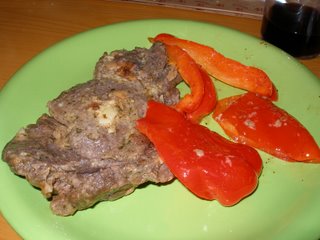 and some good company...
and some good company...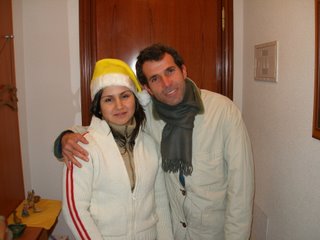
MERRY CHRISTMAS EVERYONE!
nuevos capítulos de mi vida (a unos 13.000 kilómetros del puente romano de Córdoba, o sea, por aquí en Manila)

Chuleta de buey a la bilbaína  and some good company...
and some good company...
MERRY CHRISTMAS EVERYONE!

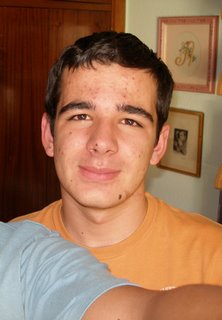 Words are not enough to describe how relieved, contented, delighted, joyous and ecstatic I am that I have finally quit teaching English. I finally said goodbye to all of my students last week, and I'm posting pictures of some of them here. Oh, how I hated surfing the Net to look for grammar exercises, cutting out stupid visual aids, and having to commute and to show up at their doorstep with a plastic folder in my hands for the past one year or so. At last, all of that is now a thing of the past! And yet I would be lying if I said that I wouldn't miss my students. Their company, which perhaps made my teaching stint less nerve-racking than it would have been, will definitely be missed. The high school teenager you see on the left is Neto, who was my longest student for eight months. Right below are José María, Máximo, Cristina and Lourdes (who are actually fraternal twins), and the very adorable Ángel and Miguel.
Words are not enough to describe how relieved, contented, delighted, joyous and ecstatic I am that I have finally quit teaching English. I finally said goodbye to all of my students last week, and I'm posting pictures of some of them here. Oh, how I hated surfing the Net to look for grammar exercises, cutting out stupid visual aids, and having to commute and to show up at their doorstep with a plastic folder in my hands for the past one year or so. At last, all of that is now a thing of the past! And yet I would be lying if I said that I wouldn't miss my students. Their company, which perhaps made my teaching stint less nerve-racking than it would have been, will definitely be missed. The high school teenager you see on the left is Neto, who was my longest student for eight months. Right below are José María, Máximo, Cristina and Lourdes (who are actually fraternal twins), and the very adorable Ángel and Miguel.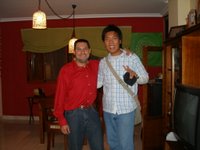
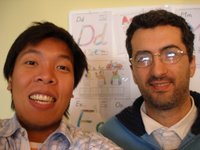


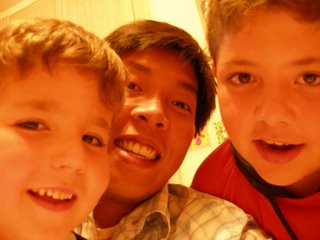
 I met with my Brazilian buddies Patricia, Julia and Adesly this afternoon to have lunch in a Brazilian restaurant to celebrate Patricia's third year in Spain. I'd promised myself not to pig out, as I usually do in eat-all-you-can restaurants, but there was simply so much food! The waiters kept on making the rounds to drop off all sorts of grilled meat on your plate that you hardly have time to breathe and think before taking the next bite. We went out of the restaurant exceptionally fed, and with bloated tummies! Here are some pics...
I met with my Brazilian buddies Patricia, Julia and Adesly this afternoon to have lunch in a Brazilian restaurant to celebrate Patricia's third year in Spain. I'd promised myself not to pig out, as I usually do in eat-all-you-can restaurants, but there was simply so much food! The waiters kept on making the rounds to drop off all sorts of grilled meat on your plate that you hardly have time to breathe and think before taking the next bite. We went out of the restaurant exceptionally fed, and with bloated tummies! Here are some pics...
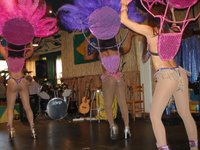


 I've been reading literature quite a lot lately, at least more than I used to since I graduated from college. The last book that I read, La Historia del Rey Transparente, was surprisingly like olive oil. It tastes good but you shouldn't take in too much of it. However, I stumbled upon a nice passage from the book which I would like to share. I'm not sure whether my translation captures the impact of the original, but here goes:
I've been reading literature quite a lot lately, at least more than I used to since I graduated from college. The last book that I read, La Historia del Rey Transparente, was surprisingly like olive oil. It tastes good but you shouldn't take in too much of it. However, I stumbled upon a nice passage from the book which I would like to share. I'm not sure whether my translation captures the impact of the original, but here goes: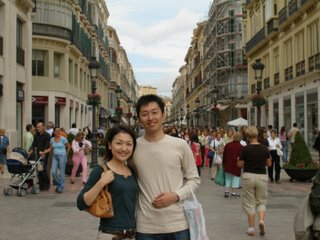 This is Tomomi and Yasuaki. For those who are not familiar with Japanese names, Tomomi is a she and from there the rest is easy. I've known Tomomi for some seven years now through a cultural program in Tokyo which we both participated in. It turns out that she tied the knot with Yasuaki last May and they decided to come to Spain for a belated honeymoon. It was fun to see them again! I got to play Mr. Tour Guide -- as I always do whenever some friends happen to be around the area -- and invited the couple to have dinner in my flat. Modesty aside, I must compliment myself for not messing up the food this time. My culinary skills are above average under normal circumstances. Yet for some reason, something fails whenever I cook in volume. So I was surprised (and almost bewildered) when everything turned out fine last week, except for the steak which kind of came out rock-hard because it wasn't completely defrosted before frying. No matter how disastrous that sounds, I was actually delighted. I've hosted more embarrassing dinners in the past :--)
This is Tomomi and Yasuaki. For those who are not familiar with Japanese names, Tomomi is a she and from there the rest is easy. I've known Tomomi for some seven years now through a cultural program in Tokyo which we both participated in. It turns out that she tied the knot with Yasuaki last May and they decided to come to Spain for a belated honeymoon. It was fun to see them again! I got to play Mr. Tour Guide -- as I always do whenever some friends happen to be around the area -- and invited the couple to have dinner in my flat. Modesty aside, I must compliment myself for not messing up the food this time. My culinary skills are above average under normal circumstances. Yet for some reason, something fails whenever I cook in volume. So I was surprised (and almost bewildered) when everything turned out fine last week, except for the steak which kind of came out rock-hard because it wasn't completely defrosted before frying. No matter how disastrous that sounds, I was actually delighted. I've hosted more embarrassing dinners in the past :--)
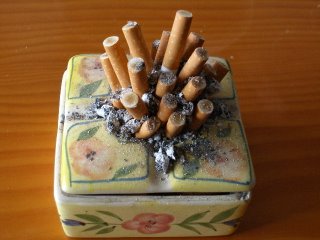
 Belém. Strictly speaking, Belém is still part of Lisbon except that it is six kilometers from the city center and looks like a different world altogether. It sits by the river and offers a splendid view of the waters lined by a bridge so tall it is almost a skyscraper! Belém's main attraction is a 16th-century monastery declared by UNESCO as a world heritage site, which transports you back into an era long gone as soon as you step into it. Here's a picture of the lovely cloister.
Belém. Strictly speaking, Belém is still part of Lisbon except that it is six kilometers from the city center and looks like a different world altogether. It sits by the river and offers a splendid view of the waters lined by a bridge so tall it is almost a skyscraper! Belém's main attraction is a 16th-century monastery declared by UNESCO as a world heritage site, which transports you back into an era long gone as soon as you step into it. Here's a picture of the lovely cloister. Sintra. Before we decided to go to Portugal, I'd told Jose Maria that we must strive to do some physical activity, aside from the usual church-hopping which he liked no end. Sintra was the closest we got to being "physical." There was a fairy-tale-like castle on top of a hill from where, on our way back, we had to hike because a fallen tree somewhere had blocked the roads that the buses couldn't pass. We saw a lot of trees, some ducks, horses, and a rather boring lake. Not bad, haha! Here's a picture of the castle.
Sintra. Before we decided to go to Portugal, I'd told Jose Maria that we must strive to do some physical activity, aside from the usual church-hopping which he liked no end. Sintra was the closest we got to being "physical." There was a fairy-tale-like castle on top of a hill from where, on our way back, we had to hike because a fallen tree somewhere had blocked the roads that the buses couldn't pass. We saw a lot of trees, some ducks, horses, and a rather boring lake. Not bad, haha! Here's a picture of the castle.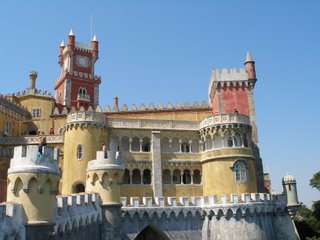 Évora. This place is white. The houses, the public buildings, even the restaurants are white. It reminds me of the Spanish region of Andalucia where most of the old houses are white. The only thing that's not white in Évora is the cathedral and some unpainted buildings that have retained their natural stone color. The historic centre, also a UNESCO-protected site, constitutes a small town in itself and is set apart from the rest of the city by walls. Here's a picture of a white building.
Évora. This place is white. The houses, the public buildings, even the restaurants are white. It reminds me of the Spanish region of Andalucia where most of the old houses are white. The only thing that's not white in Évora is the cathedral and some unpainted buildings that have retained their natural stone color. The historic centre, also a UNESCO-protected site, constitutes a small town in itself and is set apart from the rest of the city by walls. Here's a picture of a white building.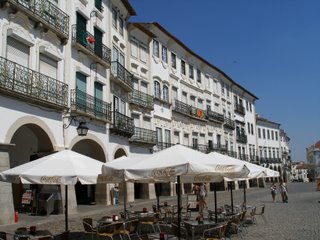 Fátima. On our fifth day in Portugal, we found ourselves with nowhere to go. The previous night, we had been to check out the gay scene in Lisbon (which didn't amount to anything really), so we woke up with bloodshot eyes and a mild headache. At the bus station we wanted to pick a destination at random and it somehow occurred to us to visit Fátima. The city itself is not a marvel but the Virgin's apparition to Lúcia, Francisco and Jacinta piques the curiosity of many. The place was filled with pilgrims, camp sites and rosaries for sale. Here's a picture of some devotees who walk on their knees from the southern part of the square to the miracle site.
Fátima. On our fifth day in Portugal, we found ourselves with nowhere to go. The previous night, we had been to check out the gay scene in Lisbon (which didn't amount to anything really), so we woke up with bloodshot eyes and a mild headache. At the bus station we wanted to pick a destination at random and it somehow occurred to us to visit Fátima. The city itself is not a marvel but the Virgin's apparition to Lúcia, Francisco and Jacinta piques the curiosity of many. The place was filled with pilgrims, camp sites and rosaries for sale. Here's a picture of some devotees who walk on their knees from the southern part of the square to the miracle site.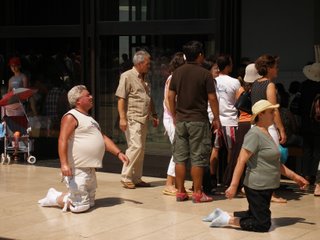 Coimbra. We arrived in Coimbra on Sunday morning so the place seemed peaceful and dreamy. Only a few cars were on the streets and most commercial establishments were closed. If there's one thing I liked about this city it certainly was the university, which the Portuguese consider as the "Oxford of Portugal" because it is old and has great architectural value, unlike most modern European universities. A small corner of the 18th-century library is shown in the following picture.
Coimbra. We arrived in Coimbra on Sunday morning so the place seemed peaceful and dreamy. Only a few cars were on the streets and most commercial establishments were closed. If there's one thing I liked about this city it certainly was the university, which the Portuguese consider as the "Oxford of Portugal" because it is old and has great architectural value, unlike most modern European universities. A small corner of the 18th-century library is shown in the following picture.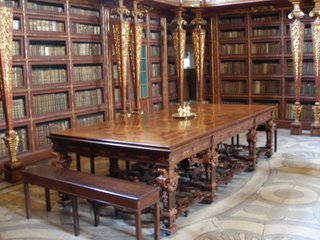 Oporto. Old houses, huge crowds. Pretty much resembles the 19th-century Manila I've seen in black and white photos. I consider Oporto one of the most memorable for four reasons. First, because on the day that I had to wash my clothes all the laundry shops seemed closed and I felt seriously threatened to put on used underwear. Second, because we group-toured a wine stockhouse and it was my first time to go to a wine-tasting (pic below). Third, because Oporto wine is sweet and has 20% alcohol content! Fourth, because it rained a lot even if it was summer.
Oporto. Old houses, huge crowds. Pretty much resembles the 19th-century Manila I've seen in black and white photos. I consider Oporto one of the most memorable for four reasons. First, because on the day that I had to wash my clothes all the laundry shops seemed closed and I felt seriously threatened to put on used underwear. Second, because we group-toured a wine stockhouse and it was my first time to go to a wine-tasting (pic below). Third, because Oporto wine is sweet and has 20% alcohol content! Fourth, because it rained a lot even if it was summer. Braga. This is one place I don't remember a lot about. I think it's got the usual churches and other historical stuff. We were supposed to go to Bom Jesus do Monte, a church perched on a hilltop, but we missed the city bus, which made us miss the funicular, which gave us no time to hike all the way to the church because we had already bought the tickets for the ride back to Oporto. To José María's disappointment, we just meandered around the foot of the hill. Here's a picture of the main plaza.
Braga. This is one place I don't remember a lot about. I think it's got the usual churches and other historical stuff. We were supposed to go to Bom Jesus do Monte, a church perched on a hilltop, but we missed the city bus, which made us miss the funicular, which gave us no time to hike all the way to the church because we had already bought the tickets for the ride back to Oporto. To José María's disappointment, we just meandered around the foot of the hill. Here's a picture of the main plaza.
 León. The road trip from Oporto took about ten hours so we arrived in León at night. We went out of the hostel to take a walk and sat on a bench in front of the cathedral. Apparently deceived by my oriental looks, a Japanese couple approached us to ask me to take their picture. After the shot, the woman attempted some small talk and was surprised that I was talking to her in Japanese even if I had just told her I was Filipino. That incident reminded me how long I hadn't used my Japanese...whew! Here's a sample of what's inside the lovely cathedral.
León. The road trip from Oporto took about ten hours so we arrived in León at night. We went out of the hostel to take a walk and sat on a bench in front of the cathedral. Apparently deceived by my oriental looks, a Japanese couple approached us to ask me to take their picture. After the shot, the woman attempted some small talk and was surprised that I was talking to her in Japanese even if I had just told her I was Filipino. That incident reminded me how long I hadn't used my Japanese...whew! Here's a sample of what's inside the lovely cathedral. Salamanca. In Filipino, the name of this place means magic, and indeed it is magical, for José María at least. He adores the place so much that he was at once incredulous and threatening when I told him it was somewhat visually boring. I thought Salamanca was lovely, but the uniform stone color of the buildings in the historic center was quite monotonous, unlike the varied hues of the old houses in Oporto. Here's a picture of the Casa de las Conchas, or the Shell House, which looks much better in picture than it really is.
Salamanca. In Filipino, the name of this place means magic, and indeed it is magical, for José María at least. He adores the place so much that he was at once incredulous and threatening when I told him it was somewhat visually boring. I thought Salamanca was lovely, but the uniform stone color of the buildings in the historic center was quite monotonous, unlike the varied hues of the old houses in Oporto. Here's a picture of the Casa de las Conchas, or the Shell House, which looks much better in picture than it really is.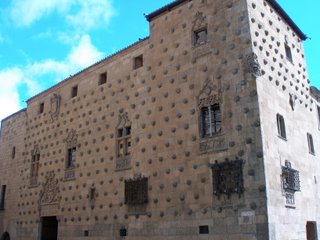 Segovia. One thing that surprised me about Segovia (aside from its breath-taking cathedral, its 1st-century Roman aqueduct and the alcázar) is that it is so expensive. At lunchtime, we had a rather difficult time scouting for a place that would suit our shoestring budget, since most restaurants were offering a standard two-course meal at 20 euros! For the first time in Spain, I felt like I was in France! Right below is a picture of the very old but still standing Roman aqueduct.
Segovia. One thing that surprised me about Segovia (aside from its breath-taking cathedral, its 1st-century Roman aqueduct and the alcázar) is that it is so expensive. At lunchtime, we had a rather difficult time scouting for a place that would suit our shoestring budget, since most restaurants were offering a standard two-course meal at 20 euros! For the first time in Spain, I felt like I was in France! Right below is a picture of the very old but still standing Roman aqueduct.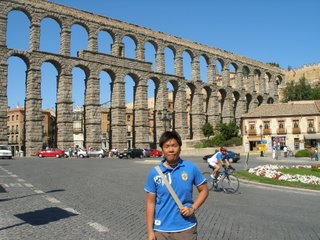
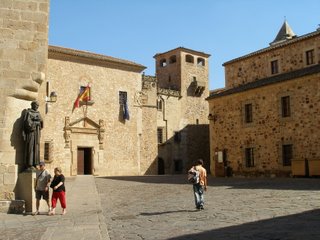 Mérida. I'd heard good things about Mérida even before, but all that went down the drain as soon as we got there. Aside from some major sights like the Templo de Diana and the Teatro Romano, the only thing that Mérida can boast is archeological ruins dating back to the Roman times. We gawked at A LOT of rocks -- or whatever's left of the settlements that used to occupy the city -- I almost wanted to study them. Here's a picture of the Teatro Romano.
Mérida. I'd heard good things about Mérida even before, but all that went down the drain as soon as we got there. Aside from some major sights like the Templo de Diana and the Teatro Romano, the only thing that Mérida can boast is archeological ruins dating back to the Roman times. We gawked at A LOT of rocks -- or whatever's left of the settlements that used to occupy the city -- I almost wanted to study them. Here's a picture of the Teatro Romano.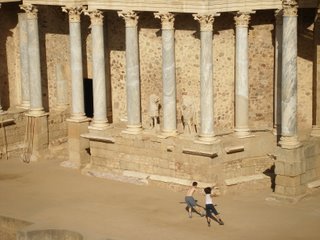
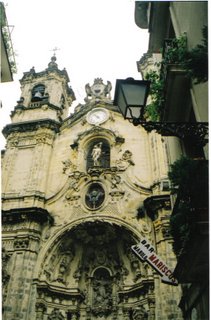 Two months ago I was at the height of thesis work. I was so burned out and tired of thinking I thought there was no other way to keep me from going nuts but to reward myself with a few days of completely brainless existence. So I searched the Net for low-cost flights (and there are many in Europe) and booked a weekend flight to northern Spain. The journey didn't turn out to be an entirely brainless activity, but spending a few days in Bilbao, San Sebastián and Logroño (May 5-8) did keep me within the bounds of sanity.
Two months ago I was at the height of thesis work. I was so burned out and tired of thinking I thought there was no other way to keep me from going nuts but to reward myself with a few days of completely brainless existence. So I searched the Net for low-cost flights (and there are many in Europe) and booked a weekend flight to northern Spain. The journey didn't turn out to be an entirely brainless activity, but spending a few days in Bilbao, San Sebastián and Logroño (May 5-8) did keep me within the bounds of sanity.



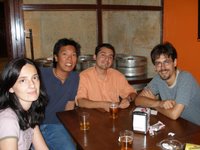



 By now you must have heard that there's a certain Dane Cook that exists in the US and that he is making waves of tsunami proportions in the stand-up comedy scene. So much so that TIME magazine picked him for its annual TOP 100 World's Most Influential People issue. It was Ashley who introduced me to his website a year ago and since then I must admit that I've been a fan. Man, this guy is true energy, if he were a drug, he would certainly be classified as illegal, because he'd be likely to cause a heart attack. He is good-looking (according to Ashley, and I agree) unlike the typical, funny-face comedian, and most of important of all, he's got talent.
By now you must have heard that there's a certain Dane Cook that exists in the US and that he is making waves of tsunami proportions in the stand-up comedy scene. So much so that TIME magazine picked him for its annual TOP 100 World's Most Influential People issue. It was Ashley who introduced me to his website a year ago and since then I must admit that I've been a fan. Man, this guy is true energy, if he were a drug, he would certainly be classified as illegal, because he'd be likely to cause a heart attack. He is good-looking (according to Ashley, and I agree) unlike the typical, funny-face comedian, and most of important of all, he's got talent. As soon as the plane touched down in Malaga, I promised to myself: "I will get a fucking haircut." As it was, my hair was already too long that all throughout the trip I had to apply scandalous amounts of gel just to keep it from blocking my eyes. My fear was that I would bump into someone on the road or just fall into the river or something. So on the day I arrived from Bilbao, one of my first errands was to scout for a decent-looking parlor downtown. My heart wanted something radically different from my usual hairstyle (see pic on the left), but at the same time I didn't like to ruin my usual "respectable" look (hmmm...). Hair, after all, takes a while to grow. To make the story short, it turned out that I would settle for the "cresta" (see pic below), a punk-like cut whose name in Spanish evokes images of standing chicken feather. In front and at both sides, it seems like a semi-military cut but as soon as you look at the back of the head you will find a hidden suprise of thick and long hair. In the pictures below it may not seem too obvious, but I think I look quite scary in this haircut. Hahaha. So this is it, my summer look. What do you think?
As soon as the plane touched down in Malaga, I promised to myself: "I will get a fucking haircut." As it was, my hair was already too long that all throughout the trip I had to apply scandalous amounts of gel just to keep it from blocking my eyes. My fear was that I would bump into someone on the road or just fall into the river or something. So on the day I arrived from Bilbao, one of my first errands was to scout for a decent-looking parlor downtown. My heart wanted something radically different from my usual hairstyle (see pic on the left), but at the same time I didn't like to ruin my usual "respectable" look (hmmm...). Hair, after all, takes a while to grow. To make the story short, it turned out that I would settle for the "cresta" (see pic below), a punk-like cut whose name in Spanish evokes images of standing chicken feather. In front and at both sides, it seems like a semi-military cut but as soon as you look at the back of the head you will find a hidden suprise of thick and long hair. In the pictures below it may not seem too obvious, but I think I look quite scary in this haircut. Hahaha. So this is it, my summer look. What do you think?
